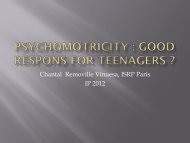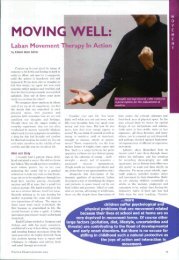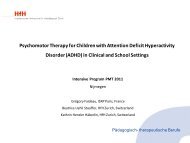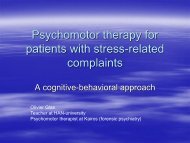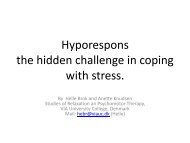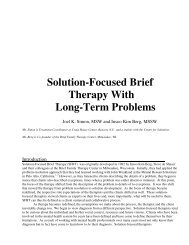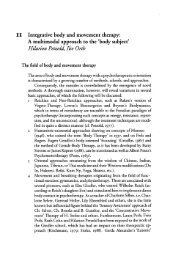Factors and Processes Contributing to Resilience
Factors and Processes Contributing to Resilience
Factors and Processes Contributing to Resilience
You also want an ePaper? Increase the reach of your titles
YUMPU automatically turns print PDFs into web optimized ePapers that Google loves.
<strong>Fac<strong>to</strong>rs</strong> <strong>and</strong> <strong>Processes</strong> <strong>Contributing</strong> <strong>to</strong> <strong>Resilience</strong> 223<br />
Rutter, M. (1992, December). Transitions<strong>and</strong> turning points in development. Paper presented<br />
at the British Psychological Society Conference, London.<br />
Rutter, M. (1993). <strong>Resilience</strong>: Some conceptual considerations. Journal of Adolescent Healtlt,<br />
14, 626--631.<br />
Rutter, M., & Quin<strong>to</strong>n, 0. (1994). Long-term follow-up of women institutionalized in childhood:<br />
Factars promoting good functioning in adult lifc. British Journal of Developmental<br />
Psychology. /8,225-234.<br />
Rutter, M., Maughan, ß., Mortimore, P., Ous<strong>to</strong>n, J., & Smith, A. (1979). Fifteenthous<strong>and</strong> hours:<br />
Secondary schools <strong>and</strong> their effects on children. Cambridge, MA: Harvard University<br />
Press.<br />
Sameroff, A. J., & Ch<strong>and</strong>ler, M. J. (1975). Reproductive risk <strong>and</strong> the continuum of caretaking<br />
casualty. In F. 0. Horawitz (Ed.), Review of child development research 4, (pp. 187-244).<br />
Chicago: Univcrsity of Chicago Press.<br />
Sameroff, A. J., Seifer, R., & Barocas. R. (1983). Impact or parental psychopathology: Diagnosis.<br />
severity, or social status effects. ft1/ant Mental Health Journal, 4(3), 236-249.<br />
Scarr, S., & McCarty, K. (1983). How people make their own environments: A theory of geno·<br />
type environment effects. Child Deve/oprnent, 54, 424-435.<br />
Schunk, D. H., & Carbonari, J. P. (1984). Self-erficacy models. In J. 0. Matarazzo, S. M. Weiss,<br />
J. A. Herd, <strong>and</strong> N. E. Miller (Eds.), Behavioral health: A h<strong>and</strong>book of hea/th (pp. 230-247).<br />
New York: Wiley.<br />
Schwarrz, J. M ., Jacobson, A. M., Hauser, S. T., & Dornbush, B. B. (1989). Explorations of vulncrability<br />
<strong>and</strong> resilience: Case studies of diabetic adolescents <strong>and</strong> their fa milies. Jn T. F.<br />
Dugan & R. Colcs (Eds.), The child in our times: Studies in the developmen.t of resiliency<br />
(pp. 134-156). New York: Brunner/Mazel:<br />
Segal, J. (1986). Winning life 's <strong>to</strong>ughest battles: Roots of human resifience. New York: McGraw<br />
Hill.<br />
Seligman, M. (1975). Helplessness: On Depression, Development, <strong>and</strong> Death. San Francisco:<br />
Frecman.<br />
Selman, R. L. ( 1980). The growth of interpersonal underst<strong>and</strong>ing: Deve/opmenta{ <strong>and</strong> clinical<br />
analysis. New York: Academic Press.<br />
Spivack, G., & Shure, M. 8. (1982). The cognition of social adjustment: Interpersonal cognitive<br />
problem-solving thinking.ln B. B. Lahey & A. E. Kazdin (Eds.), Advances in Clinical Child<br />
Psychology (pp. 323-372). New York: Plenum Press.<br />
Spivack, G., Platt, J. J., & Shure, M. (1976). The problem-solving approach ro adjustmenr. San<br />
Francisco: Jossey-Bass.<br />
Staudinger, U. M., Marsiske, M., & Balles, P. B. (1993). <strong>Resilience</strong> <strong>and</strong> Ieveis of reserve capacity<br />
in latcr adulthood: Perspective from life-span theory. Developmenl an.d Psy·<br />
clzoparhology, 5, 541-566.<br />
S<strong>to</strong>uthamcr-Loeber, M., Loeber, R., Farring<strong>to</strong>n, D. P., Zhang, Q., Van Kammen, W., & Maguin,<br />
E. ( 1993). l11e double edge of proteelive <strong>and</strong> risk fac<strong>to</strong>rs ror delinquency: Interrelations<br />
<strong>and</strong> developmental patterns. Developmem <strong>and</strong> Psychopathology, 5, 683-701.<br />
Strauss, B. G., & Glaser, A. L. (1967). The Discovery of Grmmded Theory. Chicago: Aldine.<br />
Swearingen, E. M., & Cohen, L. H. (1985). Measurernent or adolescents' life events: A Junior<br />
HighLife Experiences Survey. American Journal of Community Psychology, 13,69-85.<br />
Tarter, R., & Mezzich, A. (1992). On<strong>to</strong>geny of substance abusc: Perspectives <strong>and</strong> findings.<br />
In M. Glantz <strong>and</strong> R. Pickens (Eds.), Vulnerabi/ity <strong>to</strong> drug abuse. American Psychiatrie<br />
Association.<br />
Tay lor, S. E. ( 1983 ). Adj ustmen t <strong>to</strong> threatening even ts: A theory of cogni tive adapt ation. A merican<br />
Psyclzologist, 38, 1161-1173.





